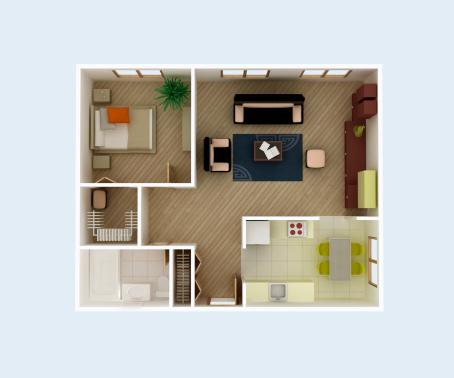Designing and building your dream home is an exciting journey, and one of the crucial decisions you’ll face is selecting the perfect floor plan. The floor plan determines the flow, functionality, and overall feel of your home, making it essential to choose wisely. This comprehensive guide will walk you through the process, providing valuable insights and tips to help you make an informed decision that aligns with your lifestyle and preferences.
Selecting the perfect floor plan for your dream home is a significant step towards creating a space that reflects your lifestyle and meets your needs. By assessing your requirements, evaluating flow and layout, considering functionality, and seeking professional advice, you can make an informed decision that will lay the foundation for a home that brings joy and satisfaction for years to come.
Assess Your Needs and Lifestyle:
Before diving into the specifics, take time to evaluate your needs and lifestyle. Consider factors such as family size, daily routines, hobbies, and future plans. This assessment will serve as a foundation for selecting a floor plan that caters to your unique requirements.
Determine the Size of Your Home:
Decide on the desired square footage for your home. Consider the number of bedrooms and bathrooms, common areas, and any additional spaces like a home office, gym, or playroom. Balancing your needs with available space is crucial to ensure comfort and functionality.
Analyze the Flow and Layout:
Evaluate the flow and layout of different floor plans. Think about how you want your rooms to connect and the overall circulation within the house. Consider factors such as proximity between bedrooms and bathrooms, privacy requirements, and open-concept versus compartmentalized layouts.
Consider Room Placement:
Think about the placement of specific rooms within the floor plan. For example, if you enjoy hosting gatherings, a spacious kitchen and dining area near the living room might be desirable. If you prefer a peaceful retreat, consider positioning bedrooms away from noisy areas like the garage or street-facing windows.
Assess Traffic Patterns:
Visualize how traffic will flow within your home. Ensure that high-traffic areas, such as hallways, are wide enough to accommodate smooth movement. Minimize congestion points and create natural pathways between frequently accessed spaces.
Focus on Functionality:
Consider how each room will be used and prioritize functionality. Ensure that the floor plan provides ample storage space, incorporates practical features like closets and pantry areas, and maximizes usable square footage.
Embrace Natural Light:
Take advantage of natural light by considering the placement and size of windows. A well-designed floor plan will allow for abundant daylight, enhancing the overall ambiance and reducing the need for artificial lighting during the day.
Future-Proof Your Home:
Consider your long-term plans when selecting a floor plan. Will your family grow, or do you anticipate changes in lifestyle? Opt for flexible spaces that can adapt to evolving needs, such as a bonus room that can serve as a nursery, guest room, or home office.
Personalize Your Design:
Choose a floor plan that aligns with your preferred architectural style. Whether you lean towards traditional, contemporary, or a unique fusion, ensure that the floor plan complements the desired aesthetics, both inside and out.
Seek Professional Advice:
Consult with an experienced architect or designer who can provide expert guidance and insights. They can help refine your ideas, optimize the floor plan, and ensure that all building codes and regulations are met.
Frequently Asked Questions
Question 1: How do I determine the right size for my dream home?
Answer 1: Consider your family size, lifestyle, and future needs. Evaluate the number of bedrooms, bathrooms, and additional spaces required, such as a home office or gym. Balance your needs with available space to ensure comfort and functionality.
Question 2: What factors should I consider when analyzing the flow and layout of a floor plan?
Answer 2: Think about how you want your rooms to connect and the overall circulation within the house. Consider factors such as proximity between bedrooms and bathrooms, privacy requirements, and whether you prefer an open-concept or compartmentalized layout.
Question 3: How should I assess traffic patterns within a floor plan?
Answer 3: Visualize how traffic will flow within your home. Ensure that high-traffic areas, such as hallways, are wide enough to accommodate smooth movement. Minimize congestion points and create natural pathways between frequently accessed spaces.
Question 4: Why is natural light important, and how can I incorporate it into my floor plan?
Answer 4: Natural light enhances the ambiance of your home and reduces the need for artificial lighting during the day. Consider the placement and size of windows in your floor plan to maximize the entry of natural light into your living spaces.
Question 5: How can I future-proof my home when selecting a floor plan?
Answer 5: Anticipate your future needs and changes in lifestyle. Choose flexible spaces that can adapt to evolving requirements, such as a bonus room that can serve multiple purposes, or a layout that allows for easy expansion if necessary.
Question 6: Is it important to consider the architectural style when selecting a floor plan?
Answer 6: Yes, the floor plan should complement your preferred architectural style. Ensure that the layout and flow align with the overall aesthetics you desire, both inside and outside your home.
Question 7: Should I seek professional advice when selecting a floor plan?
A7: Consulting with an experienced architect or designer is highly recommended. They can provide expert guidance, optimize the floor plan, and ensure compliance with building codes and regulations. Their expertise can help refine your ideas and create a well-designed home.
Question 8: How can I personalize the floor plan to reflect my preferences?
Answer 8: Look for customizable features within the floor plan, such as room sizes, additional spaces, or options for upgrades. Working with an architect or designer, you can tailor the floor plan to incorporate your unique style and requirements.
Question 9: What if I have specific accessibility needs or require universal design features?
Answer 9: If you have specific accessibility needs, prioritize a floor plan that accommodates those requirements. Consider features such as wider hallways, doorways, and accessible bathrooms to ensure the functionality and comfort of all residents.
Question 10: What are some common mistakes to avoid when selecting a floor plan?
Answer 10: Avoid overlooking important factors such as room placement, traffic flow, and functionality. It’s also crucial to consider your long-term plans and anticipate future needs to prevent potential regrets down the line. Taking the time to thoroughly assess and research your options will help you make an informed decision.
Consider This Before You Hire An Architect Or Buy Floor Plans From A Company

Before hiring an architect, consider the following factors to ensure you find the right professional for your project:
- Experience and Expertise: Look for an architect with relevant experience in the type of project you have in mind, whether it’s residential, commercial, or specialized structures. Check their portfolio to see if their design style aligns with your vision. Additionally, consider their expertise in sustainable design, building codes, and construction techniques.
- Credentials and Licensing: Ensure the architect is licensed and registered with the appropriate professional organizations in your country or region. Membership in architectural associations or institutes demonstrates their commitment to maintaining industry standards and continuing education.
- Reputation and References: Research the architect’s reputation and track record. Seek feedback from previous clients and ask for references. Reading online reviews or testimonials can provide insight into their work ethics, communication skills, and ability to meet deadlines.
- Compatibility and Communication: Building a good rapport and effective communication with your architect is crucial. Arrange an initial meeting or interview to discuss your project, gauge their understanding of your vision, and assess if you feel comfortable working together. Clear and open communication is key to a successful collaboration.
- Budget and Fees: Discuss the architect’s fee structure and ensure it aligns with your budget. Request a detailed breakdown of costs, including design fees, project management fees, and any additional expenses. Transparency in financial matters is essential for a smooth working relationship.
- Project Size and Scope: Consider the scale of your project and whether the architect has experience handling similar projects. Ask about their team’s capacity and availability to ensure they can dedicate sufficient time and resources to your project.
- Professional Network: Inquire about the architect’s network of consultants and contractors. A well-connected architect can recommend reliable professionals, such as structural engineers or interior designers, to complement your project.
- Understanding of Sustainability: If sustainability is important to you, discuss the architect’s approach to environmentally friendly design, energy efficiency, and sustainable building materials. Ensure they can incorporate these elements into your project effectively.
- Contract and Legal Matters: Review the architect’s standard contract thoroughly. Pay attention to clauses related to scope of work, project timelines, payment schedules, and dispute resolution procedures. Seek legal advice if needed to ensure you understand and agree to the terms before signing.
By carefully considering these factors, you can find an architect who possesses the necessary skills, experience, and collaborative approach to bring your vision to life and create a successful architectural project.

